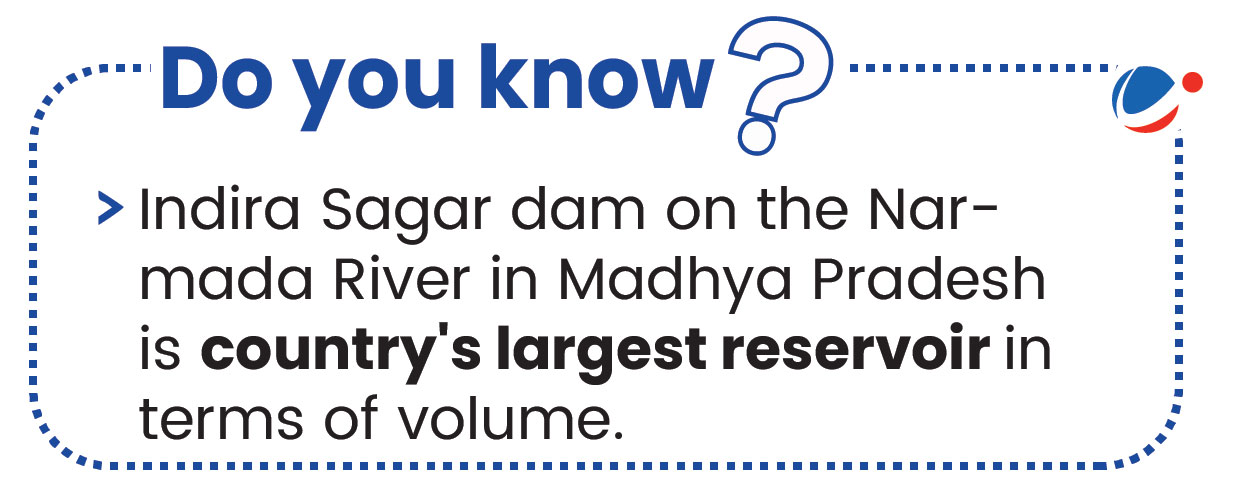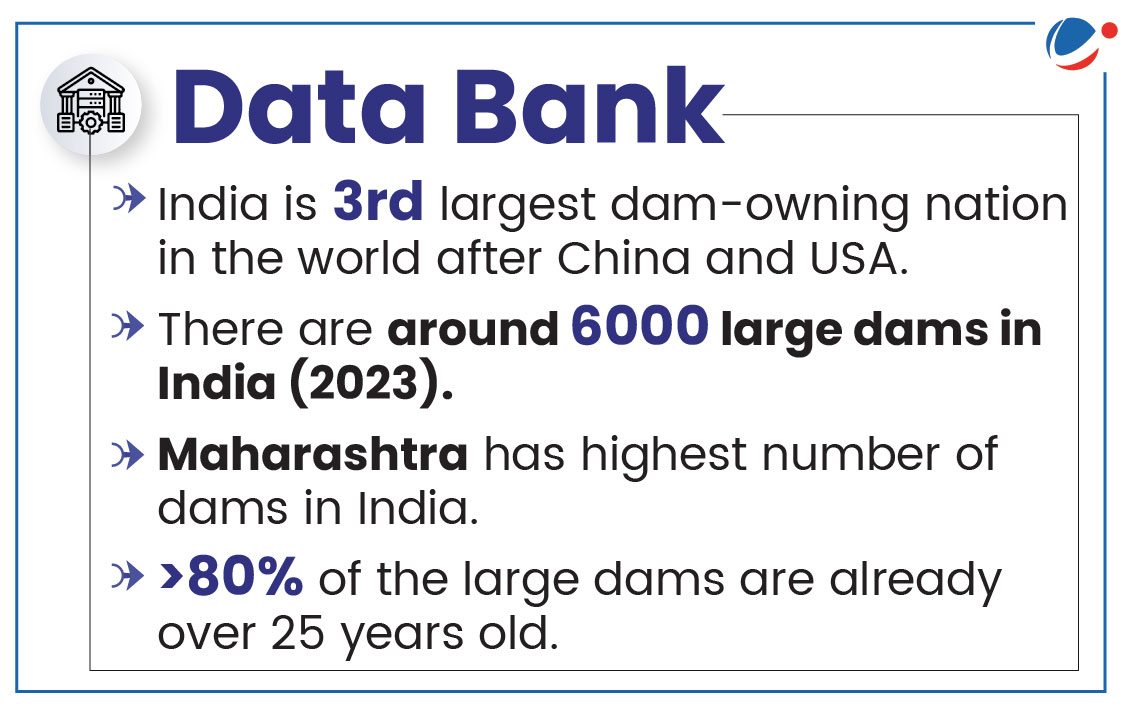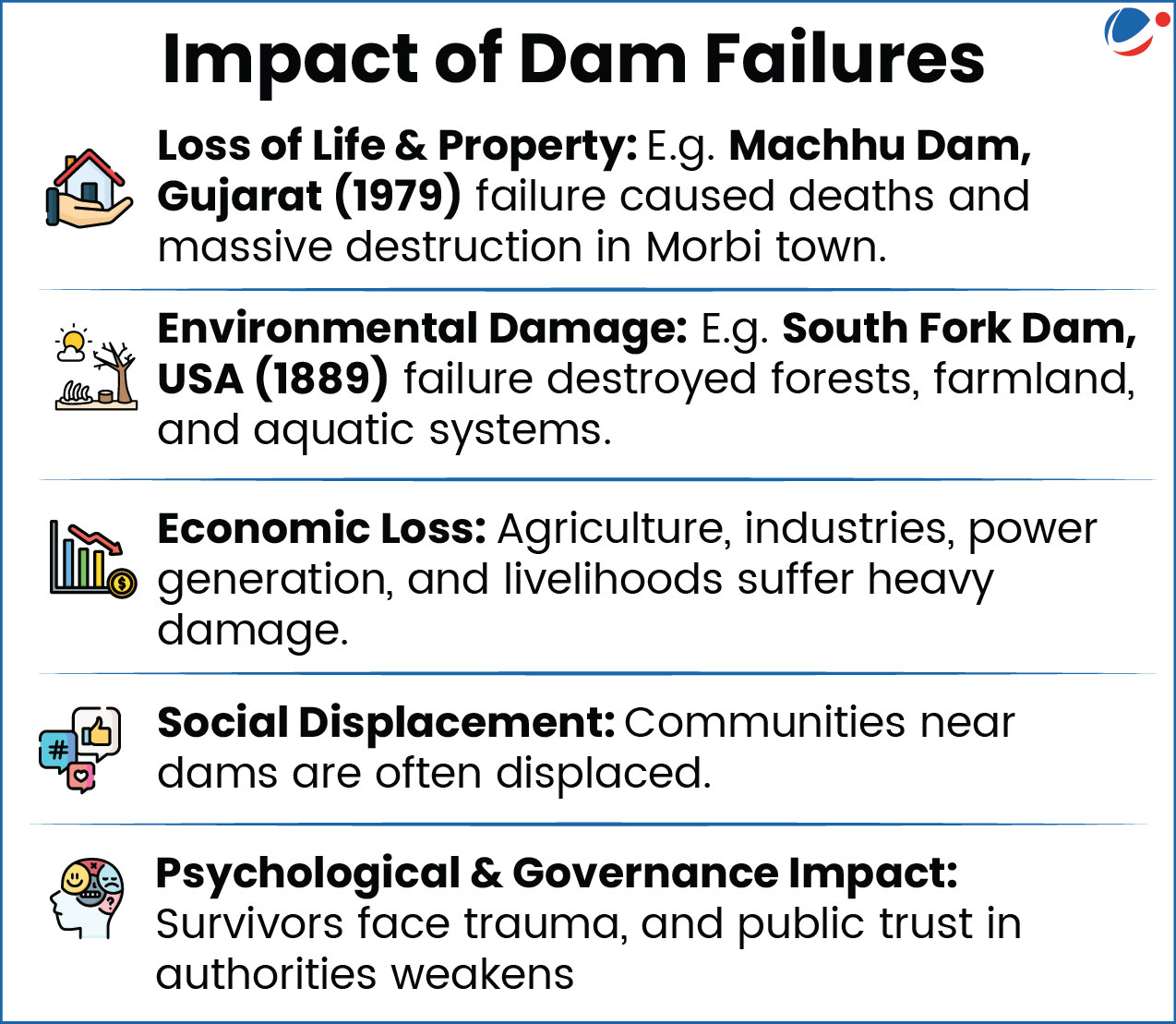
Why in the News?
Researchers from IISER Bhopal developed a comprehensive assessment of sedimentation-induced vulnerabilities in large reservoirs across India.
More on News
- The study analysed data from the Central Water Commission's recent report, 'Compendium on Sedimentation of Reservoirs in India'.
- Sedimentation is a process in which soil particles are eroded and transported by flowing water or other transporting media and deposited as layers of solid particles in water bodies.
- The study included more than 300 large reservoirs with storage exceeding 100 million cubic meters.
Key Findings on Status of Sedimentation:
 80% of large dams are over 25 years old."" width="1122" height="707">
80% of large dams are over 25 years old."" width="1122" height="707">- Many reservoirs have lost nearly or above 50% of their designed storage capacity due to sedimentation.
- By 2050, many reservoirs in East flowing rivers beyond Godavari and West flowing rivers beyond Tapi are projected to surpass 50% storage capacity loss.
- Regional Variation: Himalayan Region (HR), West Flowing Rivers, Narmada–Tapi (NT), East Flowing Rivers, and Indo-Gangetic Plains (IGP) are emerging as the vulnerable regions.
- The HR region showed the highest annual storage capacity loss due to sedimentation among all regions.
- Key Driving factors of Sedimentation: Deforestation, agricultural runoff, soil erosion due to monsoon in fragile terrains, and unregulated land-use changes.
- Consequences: Sediment starvation, reduced water security, increased energy deficits, diminished agricultural productivity and higher risks of water-related conflicts.
- E.g. East-flowing Rivers beyond Godavari (having nearly 160 reservoirs) are in a critical zone in meeting South India's agricultural and industrial water needs.
Other key Issues Associated with the Dam Safety in India
- Ageing of dams: As of 2023, out of India's large dams, 1,065 are between 50–100 years old, while 224 are more than 100 years old.
- Structural failures: It is mainly due to seepage, corroded piping, and/or weak foundations.

- Seismic vulnerability: E.g. the earthquake in Bhuj (Gujarat) in 2001, led to liquefaction in the foundation of Chang Dam.
- Vulnerability to Glacial Lake Outburst: E.g. in 2023, Chungthang Dam (Sikkim) was washed away during flash floods caused by a glacial lake outburst.
- Overtopping (flood waters pass over the dam's pinnacle): India's first recorded dam failure of the Tigra Dam in 1917, was also due to overtopping.
- Management/Compliance Issues: E.g. CAG audit report of Gandhi Sagar (Madhya Pradesh) highlighted that the State Dam Safety Organisation (SDSO) did not comply with recommendations by the CWC on remedial measures.
Initiative taken to ensure Dams Safety in India
- Dam Safety Act, 2021: Provides for proper surveillance, operation and maintenance of the specified dams to prevent dam failure. The Act has provision for setting up institutional frameworks at the Central and State level.
- At National level: National Committee on Dam Safety and National Dam Safety Authority.
- At State level: State Committee on Dam Safety (SCDS) and State Dam Safety Organization (SDSO)
- National Register of Large Dams (NRLD): It is the nationwide register of Large Dams compiled and maintained by CWC.
- Dam Rehabilitation and Improvement Project (DRIP): The 2nd and 3rd Phase of DRIP envisages comprehensive rehabilitation of 736 dams across 19 States.
- The Project receives loans from the World Bank and the Asian Infrastructure Investment Bank (AIIB).
- Seismic hazard analysis information system (SHAISYS) tool: Aims to ascertain the extent of seismic forces and their implication on the safety of the dam structures.
- Dam Safety Review Panel: Some states have created these panels for comprehensive audit of their dams.
- Other:
- National Centre for Earthquake Safety of Dams (Located at MNIT Jaipur (Rajasthan)),
- Dam Health and Rehabilitation Monitoring Application (DHARMA), Dam Safety Review Panels by States, etc.
Global steps taken to ensure Dams Safety
- World Commission on Dams: Established by the World Bank and IUCN in 1998 to review the development effectiveness of large dams and develop guidelines for the planning, monitoring and decommissioning of dams.
- International Commission on Large Dams (ICOLD): It is a non-governmental International organisation founded in 1928. It provides a forum for the exchange of knowledge in dam engineering.
- Indian National Committee on Large Dams (INCOLD) is the Indian Committee interacting with ICOLD.
Way-Forward for Ensuring Dams Safety in India
- Managing Sedimentation: Adopting best International practices like sediment bypass systems in Japan and controlled sediment flushing in Switzerland
- Implementing a region-specific approach.
- In highly vulnerable regions, targeted interventions such as afforestation, Integrated Watershed Management practices, conducting periodic Desilting operations.
- And erosion control structures (check dams) can mitigate sediment inflows.
- Implementing a region-specific approach.
- Subsurface dams: Countries like Japan have created multiple sub-surface dams as an alternative to surface dams. This could be replicated in India as well.
- Use of Technology: E.g. use of Advanced monitoring and sensing (using satellites to monitor changes in dams), using Internet of Things (IoT)-enabled sensors etc.
- Others:
- Mandatory periodic safety inspections by independent agencies.
- Dams that pose serious safety risks should be listed and then decommissioned in a phased manner.
- Developing a risk-based decision-making system to determine the most effective risk mitigation measures, and for prioritizing dam-related works.
Conclusion
India's dams face rising risks from sedimentation, ageing, seismic and climatic stresses, and weak compliance. Adopting global best practices, region-specific strategies, and phasing out unsafe structures are essential to ensure dam safety and harness the full potential of the country's water resources.




